Prasarita : Wide stance ; Pad: Foot ; Uttan : Intense stretch. Wide-legged standing forward bend with variations and full versions of the postures.
These series of postures work mostly on the hips, hamstrings, groin, adductors, and erector-spinae muscles. These can be very good postures to teach your body how to engage the particular muscles to keep your spine straight, which can be useful for many other yoga postures (mostly forward bends). In the standing forward bends, it’s a bit easier to engage the muscles because gravity is assisting you.
Postures can sometimes be tricky, if you modify them a bit then it starts working in a different way. All the muscles are connected to each other, if one muscle is tight then some other muscle might need to compensate for that. So you need to know first which area your body needs to work on and then modify accordingly. If your hamstrings are tight but you want to work on the deeper hips muscles then you might need to bend the knee a bit so that the hamstrings are released and there is still room for movement (if the legs are straight then the tight hamstrings would not let the hips and associated muscles move any further )
Another important thing to learn is to be able to engage the erector spinae (the muscles on the back which run on both sides of the spine). As the name suggests, it helps you to keep your posture erect. If you curve your back then you might not be able to engage them properly. So always work on keeping the chest open and on pushing the shoulder blades towards your butt. It’s alright if you are not able to go deeper into the pose, you would gradually be able to with practice.
Here is a variation of the posture with the help of a prop (see photo below). The stick/staff will make sure the spine is straight and the chest is open. But do not become completely reliant on the prop, this is just to show how a straighter spine is supposed to feel, learn from the props and then use the muscles to try to achieve the same feeling.
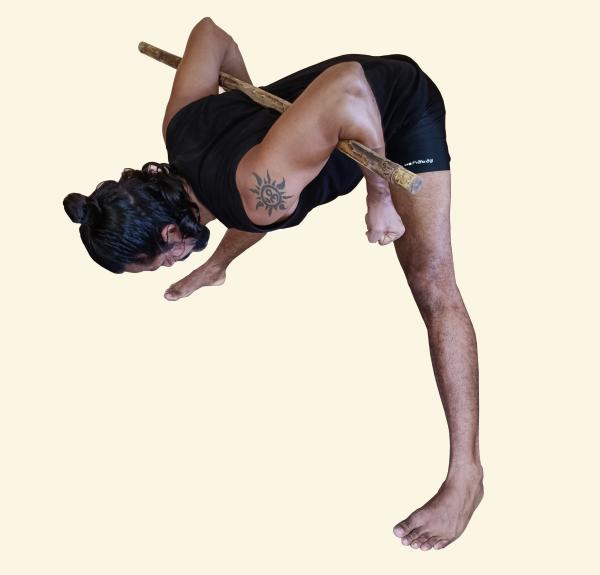
The next important thing to know about the wide-legged standing forward bend is the body proportions. This posture might look slightly different for different people. Some people have a longer upper body compared to the legs, they might find it easy to touch their head to the ground with the legs relatively closer. other people might need to keep their legs a bit more distant (do not keep the legs too wide, remember in this posture we are working on the hips and the spine muscles and learning to bend forward while keeping the spine straight, but if you are working on the splits then there is a whole different story and alignment involved).
Next in line is to learn how to use the ground (and push-pull mechanism) for the alignment. In version A of the pose the hands are on the ground, the more you push the ground the more power gets available to you. When you push the ground use that power to open the chest and move your shoulder blades towards your hips.
Prasarita Padottanasana A

In version B you are relying completely on your core and the back muscles. The more you are able to engage these muscles the deeper you can go in the pose. You can also do the above-mentioned variation with the stick if you find it hard to keep your spine straight here.
Prasarita Padottanasana B
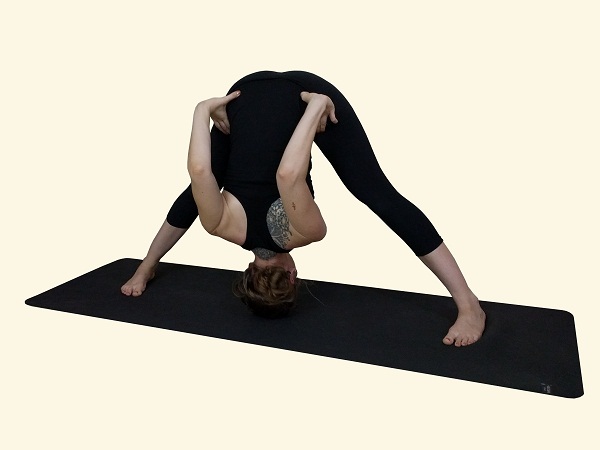
Version C of the pose is a very good stretch for the shoulders, chest, and the muscles around the shoulder blades along with the other usual areas it works on. If your chest and shoulders are blocked then you might need a strap to hold on to (See the full version and the variation below)
Prasarita Padottanasana C
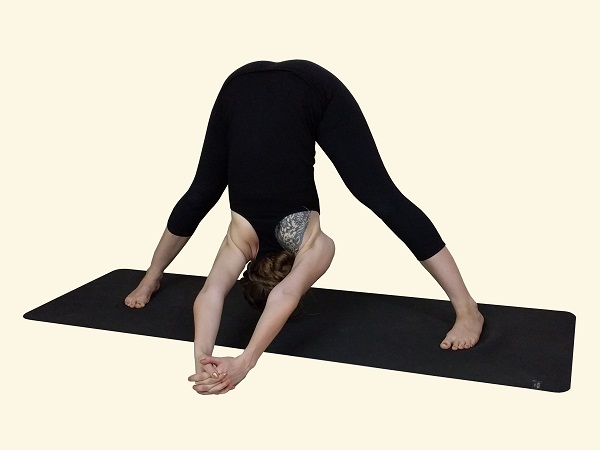
Prasarita Padottanasana C– Variation with straps
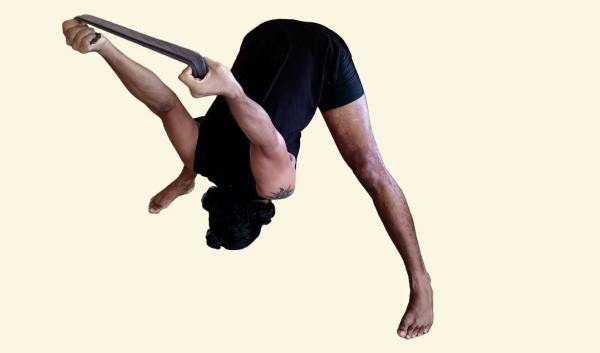
In version D you are pulling on the toes, use that pull to straighten the spine in the same way.
Prasarita Padottanasana D
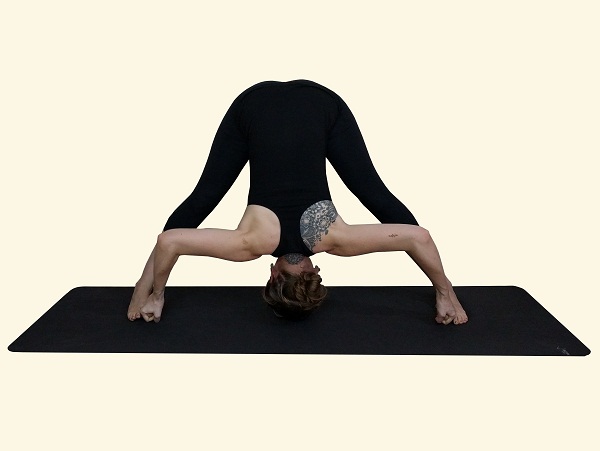
If you are wanting to include all these postures in your flow or Yoga sequence then follow the below-mentioned steps and the alignment cues. (Prasarita Padottanasana A,B,C,D are also a oart of the Standing sequence of Ashtanga Vinyasa Yoga).
Steps:
- Start from Samasthiti/Tadasana
- Inhale, turn to the right and keep your feet about one meter apart, the outer edges of your foot should be parallel to each other. (The distance between your feet depends on the ratio of the length of your spine and the leg, on average it can be about four times the length of your foot). The feet shouldn’t turn out otherwise it might put undue stress on the ligament and tendons of your knee.
- Place your hands firmly on your hips.
- Inhale and lift your entire spine and the chest up sinking the hips toward the floor. Exhale, fold forward from the hip joint, leading with your chest, and place your hands shoulder-width apart on the ground with your fingers in one line with the toes.
- Inhale, lift the chest, straighten the arms and concave the lower back to look forward (or the Drishti could be at the tip of your nose).
- Exhale fold forward, keeping the spine straight try to touch the crown of the head onto the floor in between your legs(or work on elongating your spine and try to bring the crown as close to the ground as possible).
- The elbows should be pointing back.
- Inhale come back up mid-way, keep your spine straight, and with an exhale place your hands on the hips. On the next inhale come back up to the starting position.
- You can follow the same alignment cues and vinyasa for versions B, C, and D; the only difference is the arms positions which are mentioned below.
- For B the hands are placed on the hips and elbows will move as close as possible.
- For C Interlock the hands back and bring the hands towards the ground.
- For D Hold the big toes making a hook with two fingers of your hand, and pull yourself trying to bring the crown of your head as close as possible to the ground.
Note: *People with long torsos might need to decrease the distance between their feet to have space for the neck and to keep the neck elongated. Similarly, people with long legs might need to increase their stance (but not too much as mentioned earlier).
Benefits:
- Stretches the hamstrings, adductor, and groin and opens the hips.
- Strengthens the back and the erector-spinae muscles.
- B and C stretch and open the chest.
- C and D stretch the shoulders.
Contraindications:
- Legs, hips, hamstring injury.
- Lower back injury, slip disc, sciatica, or disc prolapse.
Looking for other postures? Check our Yoga asana library.